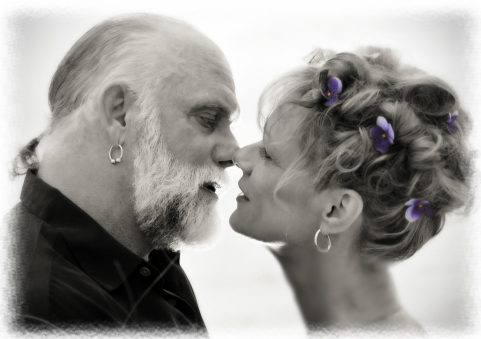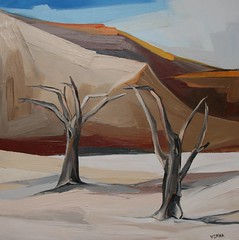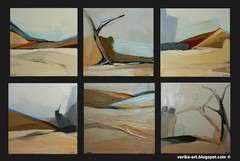|
|---|
Sunday, May 6, 2007
Notes on the show «Where Does The Light Go When It's Gone?» by João Fiadeiro.
0 comments Posted by crue at 3:46 AM Notes on «Para onde vai a luz quando se apaga?». Premiere May 4, 2007, Culturgest.
Notes on «Para onde vai a luz quando se apaga?». Premiere May 4, 2007, Culturgest.
1. The performance does not concern the disappearance of light. Rather, it is about the disappearance of shadow. The shadow of causality, of logic, of story-ness, the shadow of the human realm as we know it. Here, what we have are states. Functions. The performers don't act, they remain in action. The very first scene, where the musician walks along all the walls of the stage scratching them with a small microphone, says it all: this is going to take time, and you better deal with it. If you're not happy with it, you might just as well leave now. I will remain as long as it takes. And when it's over, it's simply gone. This doesn't need to lead anywhere but here, to the sound table. It doesn't need to tell a story other than my trip from there to here. Unsatisfied? Yes, I can understand. But can't you just appreciate it, for what it is - somebody's notion of honesty?
2. What is your function? Are you being the person that listens? Or the one that speaks? Are you the guy that draws lines? Are you the dancer girl? And what does that mean? Do you fit in when you do your thing? Do you ever not fit in? What comes out of your standing here?
3. The dancer girl - Márcia - never actually dances. She sort of warms up, tries a jump or two, prepares her body. She gets comfortable. And leaves. While she does that, a snail race is being prepared. During the general rehearsal, when Lenaic put the snails, she didn't align them to make them advance in the same direction, and they just dispersed all over. I asked her after if it was on purpose. She said no, and at the premiere they are quite carefully aligned. And I miss the havoc. I regret having asked the question.
4. The risk is huge. About half of the show is improvised. The structure remains, but the way of filling in, of respecting the tough rules of Real-Time Composition, is up to the performers, and depends on every show. It can always go wrong. It would really make more sense to see two show in a row, every time.
5. The general rehearsal goes very bad. They are aggressive, tired, unimaginative. They choose either the simplest and flat solutions, or they jump off into something completely nonsensical and unrelated. Things seem chaotic. The show ends with a quote from Deleuze, about how happiness/joy empowers. It sounds ironic.
6. The premiere goes incredibly well. Everything is right. The improvised parts all come together. The performers are strong, at first still somewhat too heavy and inexplicably over-present (too dramatic, too «significant», as if they were constantly in the middle of to be or not to be), but the performance quickly gains a good pace.
7. At a certain point, Lenaic leaves the stage with a microphone, and we hear her describing everything she sees. At the same time, Gustavo remains on stage alone, creating an abstract and quite beautiful installation. She walks up to a security guard and starts asking her questions. When asked about what was important to her in working here, the guard answers that the people she meets: «So many good experiences and good encounters. Different people. Artists, normal people...» The audience bursts with laughter. Gustavo keeps on with his paper line.
8. These beautiful visual images, all created in front of our eyes. Imagine witnessing the creation of an installation. One that includes spoken text, and maybe an actor or two, from time to time. But really, it's just like watching a construction sight. Exciting, boring, curious.
9. I talk to the performers after the show. They all seem very happy. Only at a certain point Cláudia, João's long-time collaborator, looks at me and says: «Oh my god, what is it going to be like tomorrow? I don't know why it goes well when it goes well. I still don't know.»
10. For the neophytes: don't expect a fridge.
To see a video of a fragment cut from the final version of the show, go to re-al.org, then click on Artistas - João Fiadeiro - Para Onde Vai A Luz Quando... - Filmes - 1.
Labels: performing, Portugal
Friday, May 4, 2007
After World War 2, Karl Jaspers wrote a by now classic text about guilt, The Question of German Guilt. In his taxonomy, one of the categories of guilt is the "metaphysical guilt", which could be explained as the guilt for not sacrificing ourselves to help others. That is, living our lives and not doing everything we can to make a difference.
The question is, how far can we go? Shouldn't we abandon all forms of art (and entertainment), then, if we are to concentrate all efforts on saving the world? Is there an actual possibility that it would change something?
Of course, that sounds rather extreme. (And that's why Jaspers considers this a metaphysical guilt, shared by everyone and beyond the possibility of making it disappear in any way but through self-sacrifice). But somewhere here lie very difficult issues: why should one spend my time making quite self-centered installations when one could be working in an effective, world-changing organization? Should art be justifiable, like any other product, service, activity?
It isn't about art giving the possibility to do more. Because quite frankly the above video is an exception, and works exactly because it is one. Maybe, it is about the possibility of assuming uselessness?
Beauty is a great motivator. Indeed. (In João Fiadeiro's most recent performance (soon more about that), a sentence from Deleuze (roughly remembered by me): «I started reading Leibniz's Ethics. I am discovering that joy brings more power to act»)
But can we honestly say we make art, and see art, to motivate us? Isn't it a goal in itself? And if so, can't we spend our energy in a better way? How dare we make art?
Wednesday, May 2, 2007
Here is 2 of my new paintings. The theme is exploring the Namib desert with its bold colours,
light and dark contrasts aswell as the opposing feelings/ emotions of warmth vs emptiness.
A set of six paintings to be sold seperately.
Tuesday, May 1, 2007
Here's a brilliant step in the long and often difficult challenge of playing the market's rules as an artist. More precisely, the idea is to use the same mechanism that keeps ads away from our web browsing - and turn it into art.
Adblockers are pieces of software that help filter out the commercials that appear on most web pages. Addart goes a step further - and replaces the empty left-over space with, you guessed it, art. So what you get is actually a sort of a virtual art gallery in all the places where you had publicity. Wouldn't it be nice to apply that in real life?
The work is still in prototype mode, but looks promising.
In the example below, the publicity is replaced by Mario Bros. clouds.
(via)
Labels: digital

















